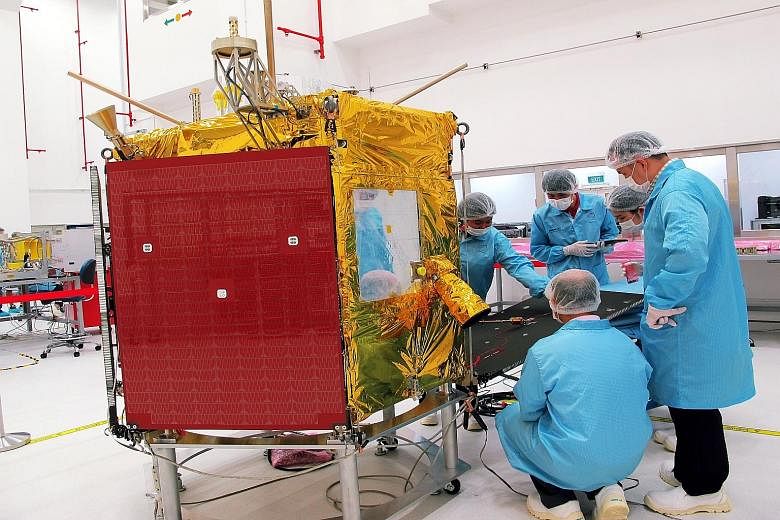1 Singapore's 'Sputnik'
Coming out of 2015, as 50 years of independence drew to a close yesterday, Singapore's scientific exploits are showing no signs of letting up.
Among the most recent achievements were the successful space launches of Singapore's first "home-made" satellites, built through collaborations among universities, defence agencies and private firms based in Singapore.
X-Sat, Singapore's very own "Sputnik", blasted off in 2011, marking the dawn of Singapore's space age.
To date, the "little satellite that could" has voyaged a distance equivalent to about 1,000 return trips to the moon.
No fewer than six new satellites followed in X-Sat's footsteps last year, the largest weighing a hefty 400kg.
2 First cancer drug to reach clinical trials
Down on Earth, Singapore's pursuit of research that benefits society has been equally strong.
Among the top contenders is the first cancer drug, ETC-159, to reach clinical trials. It was developed by researchers at the Agency for Science, Technology and Research (A*Star) and the Duke-NUS Graduate Medical School.
Conceived, made and tested in Singapore in the initial stages, the drug has been dubbed "a Singapore baby" by one of the lead scientists involved, Professor Alex Matter, CEO of A*Star's Experimental Therapeutics Centre.
Now undergoing clinical trials, ETC-159 offers hope for patients afflicted by a variety of cancers, including stomach and pancreatic cancer.
This, and other breakthroughs in science and medicine, are testimony to the long way the country has come and the diversity and versatility of its R&D capabilities.
3 Climate change champion
Associate Professor Wong Poh Poh was the only Singaporean on the Intergovernmental Panel on Climate Change (IPCC), which was jointly awarded the Nobel Peace Prize in 2007, alongside former US vice-president and environmentalist Al Gore.
Prof Wong's journey began as an undergraduate at the National University of Singapore's Department of Geography in the 1960s. After further studies, he returned to the place that had nurtured him. By the time he retiredrecently, he was widely recognised as an authority on the coastal geography of Singapore.
This is one arena in which Singapore has made a disproportionately big contribution to global efforts to combat climate change - offering the perspectives of a small and highly populated island, on which ingenuity is the way forward in mitigating the effects of sea-level rise.
4 Internet innovator still connecting
When the world entered the Internet Age, Singapore was at the cutting edge.
In the early 1990s, biochemist Tan Tin Wee came on the scene, and his new "afternoon job" with the National University of Singapore Computer Centre during those years "was to build the Internet for Singapore", according to reports.
Dr Tan pioneered numerous innovations, including a program that displayed Chinese and Tamil characters in browsers, allowing millions of Chinese and Tamil speakers in Asia to exploit the riches of the Internet for the first time.
His passion for helping the disabled led to the Singapore School for the Deaf being the first primary school with Internet access.
In 2012, he was inducted into the Internet Society's Hall of Fame in Geneva, Switzerland.
He is still at it, helping people connect online in new and powerful ways.
 Dr Lee developed the gold-plated orchid to fulfil his wife's wish that the bloom could last forever. ST FILE PHOTO
Dr Lee developed the gold-plated orchid to fulfil his wife's wish that the bloom could last forever. ST FILE PHOTO 5 Immortalising national flower
One of the early innovations in local science and technology was a gold-plated orchid developed by Dr Lee Kum Tatt, founding chairman of the Science Council.
Dr Lee's wife, Engeline, had said she wished that orchids could last forever. He obliged.
At first, he experimented at home using makeshift equipment. The technique was perfected after he got a grant from the Singapore Institute of Standards and Industrial Research to acquire proper laboratory facilities.
The intricate beauty of Singapore's signature blooms could now be captured in a form that defies wilting or rusting. His work resulted in one of the first patents from Singapore.
The earliest prototype was presented to Singapore's then First Lady, Mrs Benjamin Sheares, in 1975.
This uniquely Singapore branded souvenir has travelled, and continues to travel, the world in the pockets of countless delighted visitors to the tropical island-state.

